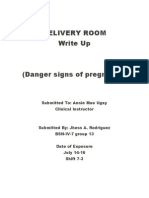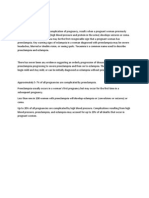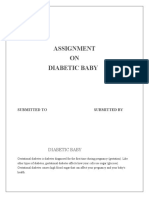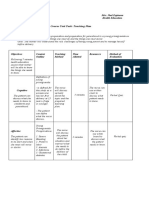Talking Points For Pet
Talking Points For Pet
Uploaded by
Jethro AchelamCopyright:
Available Formats
Talking Points For Pet
Talking Points For Pet
Uploaded by
Jethro AchelamOriginal Title
Copyright
Available Formats
Share this document
Did you find this document useful?
Is this content inappropriate?
Copyright:
Available Formats
Talking Points For Pet
Talking Points For Pet
Uploaded by
Jethro AchelamCopyright:
Available Formats
TALKING POINTS FOR PRE-ECLAMPSIA.
1. What is Pre-eclampsia?
Pre-eclampsia is a pregnancy complication that is characterized by high blood pressure. The ‘disease’
frequently occurs during pregnancy after 20 weeks (5 months) of pregnancy but can also occur after
delivery.
2. Why is pre-eclampsia such a big issue/problem for everyone?
Pre-eclampsia affects 5-8% of all pregnancies worldwide. Globally, 16% of all mothers who die during
pregnancy or childbirth do so due to pre-eclampsia. This translates to over 76,000 maternal deaths per
year.
Pre-eclampsia also significantly contributes to the death of new-borns, causing over 500,000 new-born
deaths per year,
Pre-eclampsia is currently the second leading cause of death in women during pregnancy and childbirth in
Uganda.
Pre-eclampsia was responsible for 15 % of maternal deaths in Uganda (MPDSR report of 2020/2021).
3. Who is at risk of getting pre-eclampsia?
Any woman who gets pregnant has the potential to get pre-eclampsia. However, the following categories
of women are at increased risk of suffering from pre-eclampsia when they get pregnant:
I. Women who are carrying a pregnancy for the first time (primigravida)
II. Women who had pre-eclampsia in a previous pregnancy.
III. Women who are too “young” (less than 20 years) and too “old” (more than 40 years)
IV. Women who have a family history of pre-eclampsia (either the mother or maternal aunties or siblings
have ever had p re-eclampsia)
V. Women who already have high blood pressure before pregnancy (chronic hypertension)
VI. Women who are suffering from long-term diseases such as diabetes mellitus (sugar disease), kidney
disease, and sickle cell disease.
VII. Women who are obese (too much weight for the person’s height)
VIII. Women who carrying 2 or more fetuses (multiple pregnancy)
IX. Women who delay for more than 10 years to conceive after a previous pregnancy (long
inter pregnancy interval)
X. Women who conceive through assisted reproductive technologies (IVF)
4. What symptoms do women who suffer from pre-eclampsia have?
Several women who get pre-eclampsia may not show any symptoms. Those who show symptoms may
exhibit one or more of the following:
Persistent and / or severe headache that will not go away even with painkillers.
Visual disturbances (photophobia, blurred vision, or temporary blindness)
Upper abdominal (
Altered mental status (confusion, altered behavior, or agitation)
Dyspnea or difficulty in breathing
Swelling of the face, hands, and feet
Nausea with or without vomiting after the mid-pregnancy.
Excessive weight gains or sudden increase in weight (more than 5kg per week)
5. What are the complication of pre-eclampsia to a mother and baby?
Convulsions/fits/seizures (eclampsia)
Stroke
Kidney failure
Bleeding from the birth canal before delivery (abruption-placenta)
Severe bleeding after delivery (postpartum hemorrhage)
Fluid retention in the lungs (pulmonary edema)
Liver failure
Failure of the clotting system leading to uncontrollable bleeding (DIC).
Premature birth
Being stillborn
Born too small.
6. What should a mother who has had pre-eclampsia do immediately after delivery.
Watch out for warning and danger signs and symptoms such as headache, visual disturbances, and
upper abdominal pain. Return to a health facility if these symptoms develop.
Ensure to be checked in a health facility after 1 week, 6 weeks, and 12 weeks after delivery.
Sometimes the frequency may be more depending on the mother’s condition.
Ensure a healthy lifestyle including maintaining a healthy weight, exercise, and eating healthy
foods (plenty of fruits and vegetables).
7. What can be done to reduce complications of pre-eclampsia?
Encourage all pregnant women to start attending antenatal care early (as soon as they suspect or
confirm they are pregnant).
Encourage all pregnant women to attend antenatal care regularly (as instructed by the health care
providers) and to have their blood pressure checked at all visits.
Assess all pregnant women found with high blood pressure for complications. This may require
admission to hospital.
Practice healthy lifestyles such as maintaining an appropriate weight, eating healthy foods, and
exercising regularly as appropriate for the stage of the pregnancy.
Encourage all women to deliver from health facilities.
You might also like
- NCM 109 - Care of Mother, Child at Risk or With Problems: St. Paul University Philippines Tuguegarao City, Cagayan 35000% (1)NCM 109 - Care of Mother, Child at Risk or With Problems: St. Paul University Philippines Tuguegarao City, Cagayan 35006 pages
- What Are The Factors That Put A Pregnancy at RiskNo ratings yetWhat Are The Factors That Put A Pregnancy at Risk3 pages
- Pregnancy Induced Hypertension Group 8 PresentationNo ratings yetPregnancy Induced Hypertension Group 8 Presentation55 pages
- Portfolio On M104 Clinical Management and High Risk PregnanciesNo ratings yetPortfolio On M104 Clinical Management and High Risk Pregnancies31 pages
- Pregnancy: Signs/Symptoms and Common Health Concerns50% (2)Pregnancy: Signs/Symptoms and Common Health Concerns5 pages
- An Unplanned Interruption of Pregnancy Before The Fetus Is Viable. 3. Hypertension of Pregnancy That Involves Hemolysis, High LiverNo ratings yetAn Unplanned Interruption of Pregnancy Before The Fetus Is Viable. 3. Hypertension of Pregnancy That Involves Hemolysis, High Liver3 pages
- Pregnancy Induced Hypertension (Pih) Nursing Management: EfinitionNo ratings yetPregnancy Induced Hypertension (Pih) Nursing Management: Efinition3 pages
- Risk Factors For A High-Risk Pregnancy Can IncludeNo ratings yetRisk Factors For A High-Risk Pregnancy Can Include5 pages
- Preeclampsia: Know The Symptoms. Trust YourselfNo ratings yetPreeclampsia: Know The Symptoms. Trust Yourself2 pages
- Maternal and Child Nursing 1 Skills Lab Modele s1No ratings yetMaternal and Child Nursing 1 Skills Lab Modele s13 pages
- The Internet Journal of Gynecology and ObstetricsNo ratings yetThe Internet Journal of Gynecology and Obstetrics8 pages
- Delivery Room Write Up: Submitted To: Annie Mae Ugay Clinical InstructorNo ratings yetDelivery Room Write Up: Submitted To: Annie Mae Ugay Clinical Instructor15 pages
- Module Title: Manage Antenatal Care and Promote PMTCT Module CodeNo ratings yetModule Title: Manage Antenatal Care and Promote PMTCT Module Code81 pages
- Managing Your Gestational Diabetes: A Guide for You and Your Baby's Good HealthFrom EverandManaging Your Gestational Diabetes: A Guide for You and Your Baby's Good Health1/5 (2)
- Getting Pregnant Faster: Step-By-Step Guide To Achieving PregnancyFrom EverandGetting Pregnant Faster: Step-By-Step Guide To Achieving PregnancyNo ratings yet
- Complete Download Child Development: An Active Learning Approach Third Edition - PDF Version PDF All Chapters100% (4)Complete Download Child Development: An Active Learning Approach Third Edition - PDF Version PDF All Chapters41 pages
- Head To Toe Assessment of Pregnant WomanNo ratings yetHead To Toe Assessment of Pregnant Woman8 pages
- Midwifery and Obstetrical Nursing Two Marks - 030109No ratings yetMidwifery and Obstetrical Nursing Two Marks - 03010919 pages
- Review: Diagnosis and Management of Antiphospholipid Syndrome in PregnancyNo ratings yetReview: Diagnosis and Management of Antiphospholipid Syndrome in Pregnancy7 pages
- Effects of Teenage Pregnancy On The Educational Attainment of GirlsNo ratings yetEffects of Teenage Pregnancy On The Educational Attainment of Girls9 pages
- Concepts and Perception of Health, Illness &updated100% (1)Concepts and Perception of Health, Illness &updated17 pages
- MIYCAN JAN Final Guidelines 2021 Final SignedNo ratings yetMIYCAN JAN Final Guidelines 2021 Final Signed86 pages
- Nutrition: Pregnancy AND Lactation: Enriquez R. Cayaban, RN, LPT, MANNo ratings yetNutrition: Pregnancy AND Lactation: Enriquez R. Cayaban, RN, LPT, MAN44 pages
- JIPMER - Final Submission - Revised MRMBSNo ratings yetJIPMER - Final Submission - Revised MRMBS145 pages

























































































